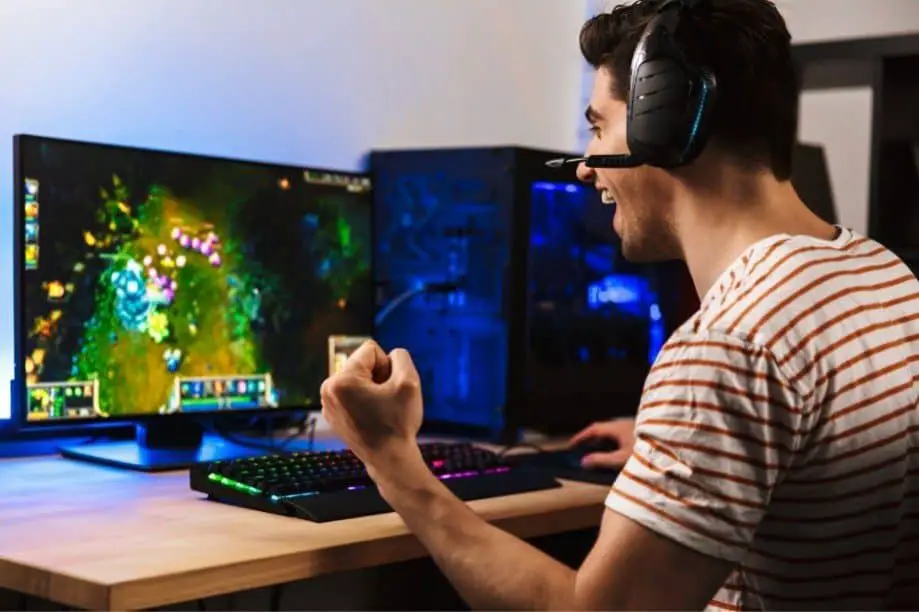
Are you in the market for a new PC monitor? Are you going to be playing video games on it every so often? If that’s the case, you probably want something that’s going to deliver a stellar gaming experience across the board.
Of course, with the number of different monitor models on the market, choosing something new is not exactly simple. The first question you might have, for example, is which type of screen to look for: gaming monitor vs. regular monitor? Is there even any difference?
We’re here to help you out with that. In fact, we’re going to teach you everything you need to know about buying a monitor for gaming: including potential pitfalls that are all too easy to overlook.
Is There Any Difference Between Regular and Gaming Monitors?
While most monitors are just fine at reproducing any sort of image from your PC, gaming monitors do, in fact, have an edge when it comes to gaming. Not a big shocker, we know, but we thought it might be wise to get that out of the way right off the bat.
Of course, any monitor can be used to do just about anything. You can game on any old office workhorse monitor, and you can edit content on any screen that’s dedicated specifically to gaming. This is hardly ever an issue.
What is important to keep in mind, however, is that specific monitors focus on delivering specific features. Creatives will want ideal color accuracy, while gamers mostly prefer fast response times and stellar refresh rates.
If you’re buying a monitor primarily for gaming, there are a number of things you’ll need to keep in mind moving forward.
Is a Gaming Monitor Better Than a Normal Monitor?
If we’re talking about playing video games specifically, then the answer is a resounding yes. A gaming monitor will outperform a regular office display by virtue of its gaming-specific features. We’ll discuss these in detail a bit later on.
Does a Gaming Monitor Make a Difference?
Provided that your PC can run games at a high enough framerate, chances are that your games will run faster than a regular, garden-variety screen could display. This will result in annoying screen-tearing, and it’s just one of the reasons a gaming monitor will make a difference.
A good gaming display will render your games quickly, it’s going to be able to keep up with your high-end graphics card without screen tearing, and it won’t cause headaches with excessive motion blur.
Is It Better To Use a Monitor or TV for Gaming
Depending on whether you’re gaming on a console or on a PC, you’re going to need to choose between a TV and a monitor. In practical terms, whichever you end up with is going to depend almost entirely on how far away from the monitor you need to sit.
Monitors are far better for PC users since they’ll usually sit up and in front of their desks, while gaming with a keyboard and a mouse. TVs will work perfectly for console gamers who might use their gaming setup as a living room centerpiece or a multimedia powerhouse.
In the end, it’s going to boil down to personal preference and individual use-case, but be sure to take your distance from the screen into consideration.
VIDEO - Gaming monitor vs Regular Monitor
What Makes a Monitor Good for Gaming?
As we said before, a great gaming monitor needs to deliver a fast and responsive video game experience across the board. If this is the first time you’re searching for a new screen, this all might sound incredibly overwhelming, but we promise that it’s really not.
Down below, we’ve assembled a list of four crucial features your gaming monitor needs to have. We’ll explain each in sufficient detail, but the bottom line is that you’ll know exactly what you’re looking for by the time you read through this section.
Low Input Lag - Lower is Better
Input lag refers to the time that passes between your GPU’s generation of an image and its on-screen appearance.
While gaming, this is perceived as the several milliseconds’ worth of difference between you making input and its subsequent effect on the game being shown. Or, for example, the time between you moving your mouse and the pointer moving on the screen.
If you’re playing a single-player game, input lag is an annoyance. If you’re playing multiplayer, it’s the stuff that’s going to get you fragged over and over again.
Naturally, you want input lag to be as low as humanly possible. The current target you should be going for about 2-4 ms, which is just about fast enough to seem imperceptible.
Fast Response Times - Lower is Better
While 'response time’ might sound like it’s a slightly fancier term for input lag, that’s not quite the case. Instead, this refers to the amount of time it takes your screen to shift from one color to another.
If you attempt to game on a screen with high response times, you’re going to be treated to a blurry and messy image when quickly turning the camera around: ghosting. If you’ve never dealt with this problem, consider yourself lucky. It’s not a hoot.
Much like input lag, response times are also measured in milliseconds, and the average is usually around 10ms for regular monitors. Gaming screens do go way lower than that, and you should try to look for a screen with response times of 5 ms or less.
High Refresh Rate - Higher is Better
The refresh rate of a monitor is the maximum number of times it can refresh an image in one second. It is measured in Hertz (Hz), and if you’ve got an even half-decent PC to run your games on, you do not want to be stuck with a classic 60 Hz panel.
It’s simple: the higher your screen’s refresh rate, the more frames-per-second it will be able to display while gaming.
Playing games at 60 FPS is perfectly fine, don’t get us wrong, but if your hardware can push 120 FPS, you’re only going to bottleneck your gaming experience by sticking with a low refresh rate monitor.
Ideally, you should go for as high of a refresh rate as possible. Modern gaming monitors can reach up to a whopping 240 Hz, but if you’re looking for a more realistic target, screens with 120 and 144 Hz panels are awesome as well.
High Resolution - Higher is Better (to a point)
Resolution is not something we need to explain in great detail, we feel. In simplest possible terms, it’s the maximum number of pixels your screen can show at any given moment.
Of course, pushing your hardware is well and good, but it’s worth pointing out that, the higher your screen’s resolution, the more taxing will it be for your hardware to run games. That’s why you want to look for a balance between a high refresh rate and a good resolution.
In 2021, the sweet spot is 1440p / 144 Hz, as that’s going to afford you a lovely and crisp image at a resolution that won’t knee-cap your GPU and let your high refresh-rate monitor go to waste.
4K is great, to be sure, but you’re not going to play many games at over 100 FPS on it, and that’s a real bummer in our book.
Can a Gaming Monitor Be Used for Other Things?
Naturally! You can use your gaming monitor to do virtually anything, from content editing all the way to regular old media consumption.
The caveat, of course, is that most gaming monitors skimp out on color accuracy out of necessity, for example. The focus of a gaming monitor panel is, after all, to deliver a fast and responsive gaming experience, and not to present the user with 100% color-accurate content.
You’ll need to weigh these features depending on your specific use case: some will need color-accurate screens for work, while others will fare perfectly fine with high-refresh gaming panels
If you’re an average gamer looking for a stellar gaming experience, don’t worry too much about color accuracy. Focus on finding a display with fast refresh rates and low response times.
You can can also see from this Reddit post below that figuring out the difference between a gaming monitor and normal monitor is quite a common question on forums and social sites.
What's the difference between a monitor and a "gaming monitor"? Looking to upgrade from my old TV from r/buildapc
Are Gaming Monitors Worth It
Are you a gamer? If yes, then we absolutely need to recommend playing on a dedicated gaming monitor. To be more exact: one that delivers in all four main areas we listed above.
There’s nothing quite like playing a game that’s rendered at 120 frames per second without any sort of screen tearing, and with your input translated into in-game action virtually immediately.
Once you experience something like this, you’ll never be able to go back to regular, run-of-the-mill office screens.
The best part of all this is that you can get a downright phenomenal gaming monitor on the cheap nowadays. Of course, the more money you can spend, the better screen you’ll get, but even mediocre gaming screens will outperform, say, a color-accurate TN panel in gaming.
That’s why gaming monitors are a crucial part of every gaming battle station under the sun, and why you definitely don’t want to get stuck with someone’s 60 Hz hand-me-down for years to come.
